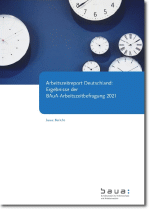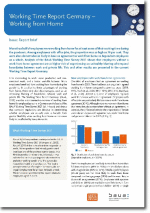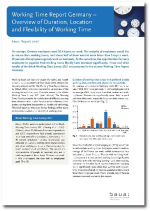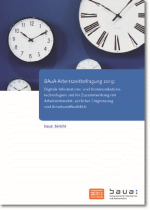Working Time Report Germany: Results of the BAuA-Working Time Survey 2021
Publikation_Sprache_Deutsch
Working time is not only a key factor for safety and health at work, but also largely determines when and how much time we have for recovery, leisure, and private life. Due to changes in the world of work, not least accelerated by the SARS-CoV-2 pandemic, working time arrangements have repeatedly been the focus of political, economic, and social debates. The Federal Institute for Occupational Safety and Health (BAuA) established the "Working Time Reporting for Germany" project already in 2015, with the BAuA-Working Time Survey as its centre. The first Working Time Report was published in 2016. In the present Working Time Report Germany, we again take a comprehensive look at the reality of working time in Germany. The year under review, 2021, was marked by the SARS-CoV-2 pandemic, which also affected the working hours of many employees. The data basis for this report is the BAuA Working Time Survey 2021, which surveyed around 20,000 employed persons in Germany who work at least 10 hours per week in their main occupation.
The Working Time Report Germany provides an overview of the prevalence and distribution of various working time dimensions in Germany. One focus is on the duration, location, and flexibility of working hours (part I). Further chapters (part II) examine different employment groups. The focus lies on working from home employees, self-employed persons, employees with multiple employments, employees in basic work, employees of retirement age (silver worker), and essential and frontline workers during the SARS-CoV-2 pandemic. The analyses of the different working time dimensions take various sociodemographic and economic characteristics into account. Furthermore, the simultaneous occurrence of working time demands with other work characteristics, presumably related to working time organization, is also examined. In addition, employee health and satisfaction with their work-life balance are analysed in relation to the dimensions of working time organization. Finally, changes in working time characteristics during the SARS-CoV-2 pandemic are separately investigated.
The results show that different employee groups are affected differently by working time demands. These are often associated with poorer health and lower satisfaction with work-life balance. Thus, the Working Time Report Germany provides information regarding the importance of various working time dimensions and their impact on employee health. The results are the starting point for further publications presenting in-depth analyses of specific working time dimensions and employee groups or occupations.
Please download the complete report "Working Time Report Germany: Results of the BAuA-Working Time Survey 2021" (in German only).
Publikation_BibliografischeAngaben
Titel: Arbeitszeitreport Deutschland: Ergebnisse der BAuA-Arbeitszeitbefragung 2021.
XAuflage.
Dortmund:
Bundesanstalt für Arbeitsschutz und Arbeitsmedizin, 2023.
ISBN: 978-3-88261-751-1, Seitenanzahl 220, Projektnummer: F 2507, Papier, PDF-Datei, DOI: 10.21934/baua:bericht20230526



